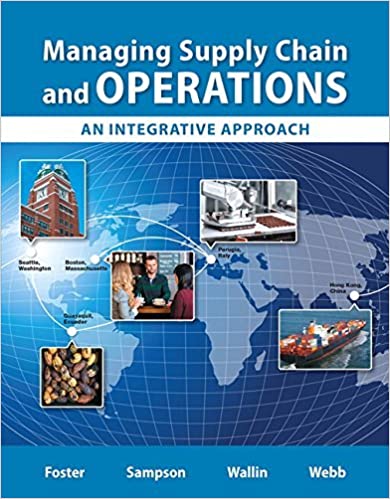
Managing Supply Chain and Operations 1st Edition by Thomas Foster ,Scott Sampson,Cynthia Wallin,Scott Webb
Edition 1ISBN: 9780134110219
Managing Supply Chain and Operations 1st Edition by Thomas Foster ,Scott Sampson,Cynthia Wallin,Scott Webb
Edition 1ISBN: 9780134110219 Exercise 9
Susan Gonzalez was puzzled. Her company, Automotive Resources, had established a favorable reputation as a supplier of parts and components to automobile assembly plants in the United States, Canada, and Mexico. She had been with die company for nearly 20 years and had watched it grow from a small company with only one plant, producing a limited number of products, to a company with five production facilities in a three-state region now supplying a variety of components for the small car, small truck, and SUV market.
Susan, now the company's vice president of production and lean operations, was facing a growing challenge. The economic downturn was threatening not only the firms profitability, but its very survival. Customers were beginning to complain about late deliveries and quality problems with parts supplied by Automotive Resources. Customers were also less willing to accept price increases now than in the past. Employees of Automotive Resources were grumbling about unpredictable work schedules, declining worker benefits, and hourly wages, which had been decreasing since the start of the economic downturn. Susan, who over her career at Automotive Resources had attended a variety of professional development programs focused on manager employee relations, quality improvement, supplier customer relationship management, lean operations, Six Sigma principles, and kaizen, knew that something significant needed to be done to better position her company in the current economy. Recently, she had been hearing more and more companies and consultants talk about sustainability and its relationship to the supply chain. She also knew that any program she implemented would have to have input from management and employees. Her customers would need to be convinced that she could supply cost-competitive, quality parts with faster response times. She also understood that her customers were now concerned about how her company was engaged in enhancing its efforts in sustainability. Susan knew that she needed to develop a program that could help address the many issues she faced. Which program would that be, and how could it be structured? If only she had a blueprint to follow.
Questions
1. Briefly describe the problems facing Automotive Resources.
2. What options do you think are available to Susan?
3. What attributes of lean management, kaizen, and Six Sigma management might be applicable to the challenges that Susan faces?
4. How can Susan and the Automotive Resources management team lead the change needed to improve the company's competitive position?
Susan, now the company's vice president of production and lean operations, was facing a growing challenge. The economic downturn was threatening not only the firms profitability, but its very survival. Customers were beginning to complain about late deliveries and quality problems with parts supplied by Automotive Resources. Customers were also less willing to accept price increases now than in the past. Employees of Automotive Resources were grumbling about unpredictable work schedules, declining worker benefits, and hourly wages, which had been decreasing since the start of the economic downturn. Susan, who over her career at Automotive Resources had attended a variety of professional development programs focused on manager employee relations, quality improvement, supplier customer relationship management, lean operations, Six Sigma principles, and kaizen, knew that something significant needed to be done to better position her company in the current economy. Recently, she had been hearing more and more companies and consultants talk about sustainability and its relationship to the supply chain. She also knew that any program she implemented would have to have input from management and employees. Her customers would need to be convinced that she could supply cost-competitive, quality parts with faster response times. She also understood that her customers were now concerned about how her company was engaged in enhancing its efforts in sustainability. Susan knew that she needed to develop a program that could help address the many issues she faced. Which program would that be, and how could it be structured? If only she had a blueprint to follow.
Questions
1. Briefly describe the problems facing Automotive Resources.
2. What options do you think are available to Susan?
3. What attributes of lean management, kaizen, and Six Sigma management might be applicable to the challenges that Susan faces?
4. How can Susan and the Automotive Resources management team lead the change needed to improve the company's competitive position?
Explanation
Brief summary of the case:
Person S is ...
Managing Supply Chain and Operations 1st Edition by Thomas Foster ,Scott Sampson,Cynthia Wallin,Scott Webb
Why don’t you like this exercise?
Other Minimum 8 character and maximum 255 character
Character 255


